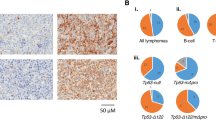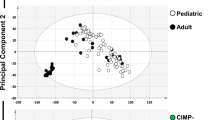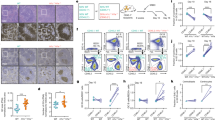Abstract
Most human lymphomas originate from transformed germinal center (GC) B lymphocytes. While activating mutations and translocations of MYC, BCL2 and BCL6 promote specific GC lymphoma subtypes, other genetic and epigenetic modifications that contribute to malignant progression in the GC remain poorly defined. Recently, aberrant expression of the TCL1 proto-oncogene was identified in major GC lymphoma subtypes. TCL1 transgenic mice offer unique models of both aggressive GC and marginal zone B-cell lymphomas, further supporting a role for TCL1 in B-cell transformation. Here, restriction landmark genomic scanning was employed to discover tumor-associated epigenetic alterations in malignant GC and marginal zone B-cells in TCL1 transgenic mice. Multiple genes were identified that underwent DNA hypermethylation and decreased expression in TCL1 transgenic tumors. Further, we identified a secreted isoform of EPHA7, a member of the Eph family of receptor tyrosine kinases that are able to influence tumor invasiveness, metastasis and neovascularization. EPHA7 was hypermethylated and repressed in both mouse and human GC B-cell non-Hodgkin lymphomas, with the potential to influence tumor progression and spread. These data provide the first set of hypermethylated genes with the potential to complement TCL1-mediated GC B-cell transformation and spread.
This is a preview of subscription content, access via your institution
Access options
Subscribe to this journal
Receive 50 print issues and online access
$259.00 per year
only $5.18 per issue
Buy this article
- Purchase on Springer Link
- Instant access to full article PDF
Prices may be subject to local taxes which are calculated during checkout






Similar content being viewed by others
Accession codes
References
Aasheim HC, Munthe E, Funderud S, Smeland EB, Beiske K, Logtenberg T . (2000). A splice variant of human ephrin-A4 encodes a soluble molecule that is secreted by activated human B lymphocytes. Blood 95: 221–230.
Aasheim HC, Terstappen LW, Logtenberg T . (1997). Regulated expression of the Eph-related receptor tyrosine kinase Hek11 in early human B lymphopoiesis. Blood 90: 3613–3622.
Bichi R, Shinton SA, Martin ES, Koval A, Calin GA, Cesari R et al. (2002). Human chronic lymphocytic leukemia modeled in mouse by targeted TCL1 expression. Proc Natl Acad Sci USA 99: 6955–6960.
Brantley DM, Cheng N, Thompson EJ, Lin Q, Brekken RA, Thorpe PE et al. (2002). Soluble Eph A receptors inhibit tumor angiogenesis and progression in vivo. Oncogene 21: 7011–7026.
Cheng N, Brantley D, Fang WB, Liu H, Fanslow W, Cerretti DP et al. (2003). Inhibition of VEGF-dependent multistage carcinogenesis by soluble EphA receptors. Neoplasia 5: 445–456.
Ciossek T, Millauer B, Ullrich A . (1995). Identification of alternatively spliced mRNAs encoding variants of MDK1, a novel receptor tyrosine kinase expressed in the murine nervous system. Oncogene 10: 97–108.
Costello JF, Fruhwald MC, Smiraglia DJ, Rush LJ, Robertson GP, Gao X et al. (2000). Aberrant CpG-island methylation has non-random and tumour-type-specific patterns. Nat Genet 24: 132–138.
Costello JF, Smiraglia DJ, Plass C . (2002). Restriction landmark genome scanning. Methods 27: 144–149.
de Saint-Vis B, Bouchet C, Gautier G, Valladeau J, Caux C, Garrone P . (2003). Human dendritic cells express neuronal Eph receptor tyrosine kinases: role of EphA2 in regulating adhesion to fibronectin. Blood 102: 4431–4440.
Dobrzanski P, Hunter K, Jones-Bolin S, Chang H, Robinson C, Pritchard S et al. (2004). Antiangiogenic and antitumor efficacy of EphA2 receptor antagonist. Cancer Res 64: 910–919.
Esteller M . (2003a). Cancer epigenetics: DNA methylation and chromatin alterations in human cancer. Adv Exp Med Biol 532: 39–49.
Esteller M . (2003b). Profiling aberrant DNA methylation in hematologic neoplasms: a view from the tip of the iceberg. Clin Immunol 109: 80–88.
Esteller M, Gaidano G, Goodman SN, Zagonel V, Capello D, Botto B et al. (2002). Hypermethylation of the DNA repair gene O(6)-methylguanine DNA methyltransferase and survival of patients with diffuse large B-cell lymphoma. J Natl Cancer Inst 94: 26–32.
Gale NW, Holland SJ, Valenzuela DM, Flenniken A, Pan L, Ryan TE et al. (1996). Eph receptors and ligands comprise two major specificity subclasses and are reciprocally compartmentalized during embryogenesis. Neuron 17: 9–19.
Galm O, Herman JG, Baylin SB . (2006). The fundamental role of epigenetics in hematopoietic malignancies. Blood Rev 20: 1–13.
Hafner C, Schmitz G, Meyer S, Bataille F, Hau P, Langmann T et al. (2004). Differential gene expression of Eph receptors and ephrins in benign human tissues and cancers. Clin Chem 50: 490–499.
Herman JG, Baylin SB . (2003). Gene silencing in cancer in association with promoter hypermethylation. N Engl J Med 349: 2042–2054.
Herman JG, Civin CI, Issa JP, Collector MI, Sharkis SJ, Baylin SB . (1997). Distinct patterns of inactivation of p15INK4B and p16INK4A characterize the major types of hematological malignancies. Cancer Res 57: 837–841.
Holmberg J, Clarke DL, Frisen J . (2000). Regulation of repulsion versus adhesion by different splice forms of an Eph receptor. Nature 408: 203–206.
Holmberg J, Frisen J . (2002). Ephrins are not only unattractive. Trends Neurosci 25: 239–243.
Hoyer KK, French SW, Turner DE, Nguyen MT, Renard M, Malone CS et al. (2002). Dysregulated TCL1 promotes multiple classes of mature B-cell lymphoma. Proc Natl Acad Sci USA 99: 14392–14397.
Kent WJ . (2002). BLAT – the BLAST-like alignment tool. Genome Res 12: 656–664.
Klein U, Dalla-Favera R . (2005). New insights into the phenotype and cell derivation of B-cell chronic lymphocytic leukemia. Curr Top Microbiol Immunol 294: 31–49.
Kondo Y, Issa JP . (2004). Epigenetic changes in colorectal cancer. Cancer Metastasis Rev 23: 29–39.
Narducci MG, Pescarmona E, Lazzeri C, Signoretti S, Lavinia AM, Remotti D et al. (2000). Regulation of TCL1 expression in B- and T-cell lymphomas and reactive lymphoid tissues. Cancer Res 60: 2095–2100.
Palmer A, Klein R . (2003). Multiple roles of ephrins in morphogenesis, neuronal networking, and brain function. Genes Dev 17: 1429–1450.
Pasquale EB . (2005). Eph receptor signalling casts a wide net on cell behaviour. Nat Rev Mol Cell Biol 6: 462–475.
Rush LJ, Dai Z, Smiraglia DJ, Gao X, Wright FA, Fruhwald M et al. (2001). Novel methylation targets in de novo acute myeloid leukemia with prevalence of chromosome 11 loci. Blood 97: 3226–3233.
Rush LJ, Plass C . (2002). Alterations of DNA methylation in hematologic malignancies. Cancer Lett 185: 1–12.
Rush LJ, Raval A, Funchain P, Johnson AJ, Smith L, Lucas DM et al. (2004). Epigenetic profiling in chronic lymphocytic leukemia reveals novel methylation targets. Cancer Res 64: 2424–2433.
Said JW, Hoyer KK, French SW, Rosenfelt L, Garcia-Lloret M, Koh PJ et al. (2001). TCL1 oncogene expression in B-cell subsets from lymphoid hyperplasia and distinct classes of B-cell lymphoma. Lab Invest 81: 1–10.
Sharfe N, Freywald A, Toro A, Dadi H, Roifman C . (2002). Ephrin stimulation modulates T cell chemotaxis. Eur J Immunol 32: 3745–3755.
Shen RR, Ferguson DO, Renard M, Hoyer KK, Kim U, Hao X et al. (2006). Dysregulated TCL1 requires the germinal center and genome instability for mature B-cell transformation. Blood 108: 1991–1998.
Surawska H, Ma PC, Salgia R . (2004). The role of ephrins and Eph receptors in cancer. Cytokine Growth Factor Rev 15: 419–433.
Teitell M, Damore MA, Sulur GG, Turner DE, Stern MH, Said JW et al. (1999). TCL1 oncogene expression in AIDS-related lymphomas and lymphoid tissues. Proc Natl Acad Sci USA 96: 9809–9814.
Teitell MA . (2005). The TCL1 family of oncoproteins: co-activators of transformation. Nat Rev Cancer 5: 640–648.
Wang J, Kataoka H, Suzuki M, Sato N, Nakamura R, Tao H et al. (2005). Downregulation of EphA7 by hypermethylation in colorectal cancer. Oncogene 24: 5637–5647.
Wimmer-Kleikamp SH, Lackmann M . (2005). Eph-modulated cell morphology, adhesion and motility in carcinogenesis. IUBMB Life 57: 421–431.
Wu J, Luo H . (2005). Recent advances on T-cell regulation by receptor tyrosine kinases. Curr Opin Hematol 12: 292–297.
Yan XJ, Albesiano E, Zanesi N, Yancopoulos S, Sawyer A, Romano E et al. (2006). B-cell receptors in TCL1 transgenic mice resemble those of aggressive, treatment-resistant human chronic lymphocytic leukemia. Proc Natl Acad Sci USA 103: 11713–11718.
Yu L, Liu C, Vandeusen J, Becknell B, Dai Z, Wu YZ et al. (2005). Global assessment of promoter methylation in a mouse model of cancer identifies ID4 as a putative tumor-suppressor gene in human leukemia. Nat Genet 37: 265–274.
Acknowledgements
This work was supported by the NIH Grants T32CA009120 (DWD), T32A107126 (RRS) T32CA09056 (SWF), HD041451 (YM), PNEY018228, R01CA90571, R01CA107300 and R01GM073981 (MAT), by the Margaret E Early Medical Research Trust, by CMISE, a NASA URETI Institute (NCC 2-1364) (MAT) and by the Intramural Research Program of the NIH, National Institute of Allergy and Infectious Diseases (HCM). MAT is a Scholar of the Leukemia and Lymphoma Society.
Author information
Authors and Affiliations
Corresponding author
Additional information
Supplementary Information accompanies the paper on the Oncogene website (http://www.nature.com/onc).
Supplementary information
Rights and permissions
About this article
Cite this article
Dawson, D., Hong, J., Shen, R. et al. Global DNA methylation profiling reveals silencing of a secreted form of Epha7 in mouse and human germinal center B-cell lymphomas. Oncogene 26, 4243–4252 (2007). https://doi.org/10.1038/sj.onc.1210211
Received:
Revised:
Accepted:
Published:
Issue Date:
DOI: https://doi.org/10.1038/sj.onc.1210211
Keywords
This article is cited by
-
DNA methylation of hematopoietic stem/progenitor cells from donor peripheral blood to patient bone marrow: implications for allogeneic hematopoietic stem cell transplantation
Clinical and Experimental Medicine (2023)
-
The role of EphA7 in different tumors
Clinical and Translational Oncology (2022)
-
Identification of the soluble EphA7-interacting protein Nicalin as a regulator of EphA7 expression
Molecular and Cellular Biochemistry (2021)
-
Receptor Tyrosine Kinase EphB3: a Prognostic Indicator in Colorectal Carcinoma
Pathology & Oncology Research (2020)
-
Therapeutic targeting of EPH receptors and their ligands
Nature Reviews Drug Discovery (2014)



